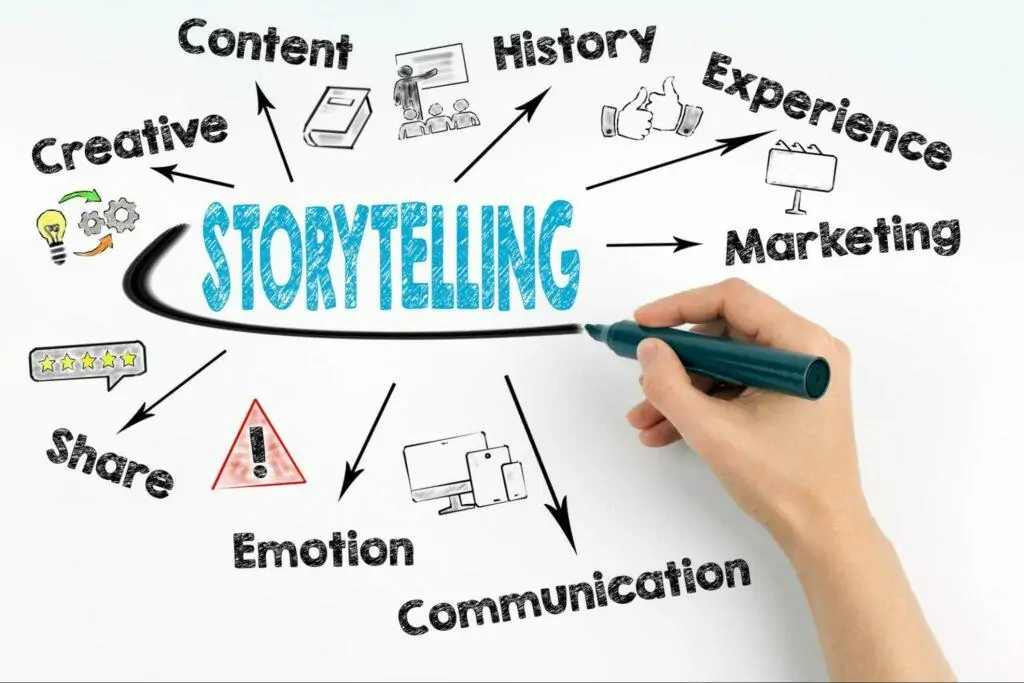Wichtige Punkte:
- Ein Pitch Deck, auch bekannt als Investor Pitch Deck, ist ein Marketingdokument, das häufig verwendet wird, um potenziellen Investoren einen Geschäftsplan zu präsentieren, eine Finanzierung zu sichern und manchmal auch, um bei einer Neueinstellung zu helfen.
- Es gibt keine Vorlage für ein Pitchdeck für Investoren, die zu jedem Unternehmen passt. Selbst die beste Pitchdeck-Vorlage kann Ihre Präsentation einschränken und entscheidende Aspekte Ihrer Markengeschichte auslassen.
- Das Schlüsselelement eines jeden Decks sollte die Erzählung sein. Sobald Sie sich darüber im Klaren sind, können Sie Ihr Pitch-Deck für Investoren darauf ausrichten und die Geschichte als Leitfaden für Ihren Inhalt verwenden, damit die Investoren eine Verbindung zu Ihrer Idee herstellen können.
- Das Ziel eines guten Pitch Decks ist es, das nächste Treffen zu erreichen, daher sollte es sich auf Ihre Erzählung in einer prägnanten und spezifischen Weise konzentrieren. Verstricken Sie sich nicht in zu viel Text, sondern achten Sie darauf, dass jedes Stückchen Text aussagekräftig und wertvoll ist.
Einführung
Ein Pitch-Deck für Investoren oder ein Pitch-Deck für Unternehmen ist eine Möglichkeit, Ihren Geschäftsplan und Ihr Wachstumspotenzial zu präsentieren, oft um eine externe Finanzierung zu erhalten. Sie brauchen ein Pitch Deck immer dann, wenn Sie Ihr Unternehmen jemandem präsentieren müssen, sei es bei der Suche nach einem neuen Mitarbeiter oder bei der Beschaffung von Finanzmitteln. Unternehmen können sogar mehrere Decks für unterschiedliche Zwecke erstellen. Zum Beispiel eine textlastige Version, die per E-Mail verschickt werden kann, und eine andere für persönliche Präsentationen. Sie können Ihr Pitch Deck sogar anpassen, indem Sie Abschnitte während der Erhöhung ändern.
Das Ziel eines Pitch Decks besteht nicht nur darin, eine Finanzierung zu sichern, sondern das nächste Treffen zu buchen. So ist die Mittelbeschaffung ein mehrstufiger Prozess; der erste Schritt besteht darin, die Investoren für Ihre Idee zu begeistern und zu faszinieren.
Jetzt wissen Sie also, wozu ein Pitchdeck gut ist. Wie erstellen Sie nun Ihr eigenes? Selbst wenn Sie die beste Pitchdeck-Vorlage verwenden, die es gibt, werden Sie wahrscheinlich einige wichtige Hinweise übersehen. In diesem Artikel erfahren Sie, was Standardvorlagen bieten, warum sie Ihren kreativen Ausdruck einschränken können und wie Sie ein Pitch Deck erstellen, das Ihre Idee tatsächlich verkauft.
Welche ist die beste Pitch Deck Vorlage?
Es gibt einige gute Vorlagen, die sich bereits bewährt haben. Es spricht nichts dagegen, sich zu informieren, um zu verstehen, was sie vorschlagen und inwiefern sie für die Erstellung des Geschäftsplans relevant sein können.
Nehmen Sie zum Beispiel das Pitch Deck von Sequoia. Es gilt als eine der besten Pitchdeck-Vorlagen auf dem Markt und bietet ein grundlegendes Format, dem die meisten Unternehmen folgen - und das aus gutem Grund. Wie Sie jedoch später feststellen werden, kann auch diese Vorlage angepasst werden, um Ihr Pitch auf die nächste Stufe zu heben.
Bei 13-19 Folien verwenden die meisten Unternehmen die folgenden Überschriften, um ihr Deck zu erstellen:
- Problem
- Lösung
- Markt
- Produkt
- Traktion
- Team
- Wettbewerb
- Finanzen
- Aufzubringender Betrag
Wie Sie sehen können, gibt es hier ein klares Layout, das Anfängern eine gute Orientierung bietet. Wenn es jedoch darum geht, den Geschäftsplan auf eine wirklich einprägsame Weise zu schreiben, müssen Sie einen anderen Ansatz wählen.
Warum Sie Standardvorlagen meiden sollten
Zu Beginn dieses Artikels haben wir über den Zweck eines Pitch Decks gesprochen. Im Kern ist ein Pitch Deck ein Marketingdokument, das sich verkaufen muss. In diesem Fall ist es der Verkauf Ihrer Geschäftsidee. Um dies zu erreichen, muss die Präsentation überzeugend sein, Emotionen wecken und die Investoren dazu bringen, etwas zu fühlen.
Wie können Sie das tun, wenn Sie in den Grenzen einer Vorlage feststecken? Damit wollen wir nicht sagen, dass alle Vorlagen nichtig sind. Wie wir bereits erwähnt haben, wurden sie immer wieder verwendet. Sie könnten sogar argumentieren, dass das, was wir im Folgenden vorstellen, eine Art "Vorlage" ist.
Was wir dagegen vorschlagen, ist, die "Regeln" zu brechen und vom Weg abzuweichen, um Ihre einzigartige Art der Präsentation zu finden und herauszufinden, wie Sie Ihre Investoren mit Ihrer Idee verbinden können. Sei es durch Aufregung, Faszination oder Leidenschaft für Ihr Angebot. Bringen Sie sie auf dieselbe Seite wie Sie und machen Sie ihnen Lust, das Problem zu lösen, das Sie identifiziert haben.
Gute Decks stellen spezifische Fragen, sind genau und absichtlich mit dem, was sie mitteilen. Das Befolgen einer Vorlage kann Sie zurückhalten, Ihre Herangehensweise einschränken und letztlich könnten Sie entscheidende Details in Ihrer Präsentation übersehen.
Wie man einen Business Pitch schreibt
Wenn Sie eine überzeugende Präsentation erstellen wollen, müssen Sie mit einer Sache beginnen (und das ist keine Vorlage).
Beginnen Sie stattdessen mit Ihrer Geschichte.
Ihre Geschichte ist einzigartig für Ihr Unternehmen und kann nicht in einer Vorlage wiedergegeben werden. Anstatt mit einer Vorlage für ein Pitch-Deck für Investoren zu beginnen, beginnen Sie mit Ihrer Geschichte und bringen sie in Deckform. Das Deck ist einfach das Medium, in dem Sie Ihre Geschichte erzählen.
Ihre Zuhörer investieren in Ihre Vision, also sagen Sie ihnen nicht nur, wie, sondern malen Sie ein Bild davon, warum diese Lösung einen Unterschied machen wird - so sprechen Sie ihre Emotionen an und verkaufen die Geschichte. Schließlich treffen wir Entscheidungen auf der Grundlage von Emotionen, nicht nur von Fakten und Zahlen.
Zeigen, nicht erzählen
In der Branche der GeschichtenerzählenEs gibt ein beliebtes Konzept, das als "show, don't tell" bekannt ist. Anstatt die Fakten für den Leser darzulegen, anzeigen warum dieses Problem angegangen werden muss, anzeigen was es bedeutet, dieses Problem zu erleben und anzeigen wie Ihre Idee das Problem löst. Sie können dies tun, indem Sie eine nachvollziehbare Geschichte erzählen oder Ihr Konzept mit Bildern veranschaulichen. Wenn Sie Ihre Zuhörer dazu bringen, ihre Vorstellungskraft zu nutzen, werden sie Ihre Vision eher verstehen und zum nächsten Treffen kommen.
Wie entscheiden Sie, was in Ihr Pitch Deck kommt?
Da das Pitch Deck eine erste Einführung in Ihren Geschäftsplan darstellt, müssen Sie darauf achten, es nicht mit Informationen zu überfrachten. Wie entscheiden Sie also, was Sie in Ihr Deck aufnehmen wollen? Im Folgenden finden Sie einige Fragen, die Sie bei der Sichtung Ihrer Fakten und Zahlen berücksichtigen sollten.
Ist das beeindruckend? - Da Sie versuchen, Ihr Publikum mit Ihrer Idee zu begeistern, müssen Sie über den Tellerrand hinausschauen. Was ist beeindruckend an Ihrem Unternehmen, Ihrem Produkt/Ihrer Dienstleistung und Ihrer Zielgruppe? Welche Aspekte machen Sie anders?
Bietet sie den notwendigen Kontext? - Ein Pitch Deck muss einen gewissen Kontext über die Arbeitsweise Ihres Unternehmens enthalten, aber Sie müssen nicht ALLES hineinschreiben. Geben Sie Ihrem Publikum genügend Informationen, um zu verstehen, was Sie tun und wie Sie es tun, aber übertreiben Sie es nicht. Wenn es gut läuft, weckt das Pitch Deck das Interesse der Zuhörer und sie stellen weitere Fragen.
Der Prozess der Erstellung eines Pitch Decks
Verfallen Sie nicht in die Falle, ein "Deck" zu erstellen. Tatsächlich brauchen Sie erst ganz am Ende des Erstellungsprozesses ein Deckformat zu verwenden. Im Gegenteil, der erste Schritt besteht darin, die Geschichte festzulegen. Machen Sie sich klar, was Sie sagen, mitteilen und begeistern wollen. Sobald Sie all das wissen, können Sie Ihre Struktur finden und sie in ein Deck-Design einbauen.
Wie man bei der Erstellung eines Pitch Decks Storytelling einsetzt:
- Definieren Sie Ihre Erzählung
- Vereinfachen Sie Ihre Geschichte in Überschriften
- Auf die Details kommt es an
- Optisches Flair hinzufügen
Dieser alternative Ansatz stellt sicher, dass Sie Ihren eigenen Stempel aufdrücken, anstatt eine andere Vorlage zu kopieren und einzufügen. Auf diese Weise vermeiden Sie Mittelmäßigkeit und schaffen eine wirklich einzigartige, kreative Präsentation.
Definieren Sie Ihre Erzählung
Der allererste und wichtigste Schritt besteht darin, Ihre Geschichte zu skizzieren. Gute Geschichten bleiben haften; sie sind überzeugend und einprägsam. Während Sie über Ihre Geschichte nachdenken, sollten Sie einige Dinge berücksichtigen:
- Woran und wie haben Sie das Problem erkannt?
- Warum löst Ihre Idee dieses Problem?
- Was bauen Sie, und wie haben Sie die Leute darauf aufmerksam gemacht?
- Haben Sie besondere Erkenntnisse oder interessante Methoden, die für Sie besonders gut funktioniert haben?
- Wie sieht die Zukunft aus, wenn Ihre Idee ein Erfolg wird?
- Was gibt es noch zu klären?
Sie können auch darüber nachdenken, wie Sie Ihre Geschichte erzählen wollen. Eine Methode beginnt mit der Beschreibung einer Welt, in der das von Ihnen identifizierte Problem besteht. Als nächstes beschreiben Sie, wie die Welt ohne dieses Problem aussehen würde. Schließlich stellen Sie die Brücke zwischen diesen Welten vor, mit anderen Worten: Ihre Geschäftsidee. Diese Formel betrachtet das Vorher und Nachher des spezifischen Problems und stellt Ihre Idee als Brücke zu einem besseren Ergebnis vor.
Eine andere Möglichkeit, an Ihre Erzählung heranzugehen, besteht darin, sie in drei Teile zu gliedern: Problem, Anregung und Lösung. Legen Sie zunächst den Rahmen fest und beschreiben Sie das Problem Ihres Zielkunden. Als Nächstes entwickeln Sie das Problem und zeigen, was es bedeutet, dieses Problem zu erleben, bevor Sie eine Lösung (Ihre Idee) anbieten.
Dieser Schritt ist von entscheidender Bedeutung, denn er bildet die Grundlage für Ihr gesamtes Angebot.

Vereinfachen Sie Ihre Geschichte in Überschriften
Ein Grund, warum wir es für gut halten, von Standardvorlagen abzuweichen, sind die Überschriften. Wenn Sie jede Folie mit Überschriften wie "Problem" oder "Team" betiteln, wird wertvoller Platz verschwendet. Lassen Sie stattdessen Ihre Geschichte die Struktur für Ihr Deck bilden. Vereinfachen Sie Ihre Geschichte in Überschriften und personalisieren Sie die Titel der einzelnen Folien, damit sie Ihre Geschichte erzählen.
Ihre Präsentation muss einprägsam, fesselnd und interessant sein. Es ist unwahrscheinlich, dass sich Ihr Publikum große Informationsbrocken merken kann, also stellen Sie sicher, dass Sie die Hauptaussage in den Überschriften wiedergeben. Eine effektive Methode, dies zu überprüfen, ist der Durchblättern-Test. Wenn jemand durch Ihre Diashow blättert, wird er Ihre Geschichte allein anhand der Überschriften verstehen? Dies ist eine gute Möglichkeit, um festzustellen, was Ihre Präsentation auf den ersten Blick vermittelt.
Kurz gesagt: So bestimmen Sie Ihre Reihenfolge. Vorlagen können mühsam sein, also halten Sie sich in erster Linie an die Reihenfolge, die Ihre Geschichte erzählt.
Auf das Detail kommt es an
Das Hinzufügen von Details kann über Erfolg oder Misserfolg Ihrer Präsentation entscheiden. Besonders bei persönlichen Präsentationen ist es wichtig, die Texte kurz und zielgerichtet zu halten. Zu den allgemeinen Regeln gehört die Begrenzung auf 30 Wörter pro Folie oder 4 Aufzählungspunkte mit jeweils 8 Wörtern.
Wenn die Überschrift fesselnd genug ist, wird Ihr Publikum weiter lesen, also müssen die begleitenden Details die nächste Stufe erreichen. Erwägen Sie, Fakten oder unterstützende Zahlen hinzuzufügen, aber achten Sie darauf, dass Sie nicht einfach die Überschrift wiederholen.
Wenn Sie sich auf ein Minimum beschränken wollen, müssen Sie Ihre Inhalte klug einsetzen. Jedes Wort zählt.
Visuelles Flair hinzufügen
Sie haben also Ihre Geschichte, haben die Überschriften optimiert und die Details hinzugefügt. Was bleibt noch übrig? Der letzte Schritt bei der Erstellung eines Pitch Decks besteht darin, es in ein Deck-Format zu bringen. In dieser Phase geben Sie die Story in Folien ein und fügen aussagekräftige und relevante Grafiken, Diagramme und Daten hinzu. Vergewissern Sie sich, dass alle Bilder, die Sie einfügen, die Geschichte, die Sie zu erzählen versuchen, unterstützen.
Bei der Zusammenstellung sollten Sie auf ein paar Details achten. Ein professionelles Business Pitch Deck ist einfach, aber bewusst gestaltet. Das bedeutet, dass Sie eine visuell ansprechende Farbpalette wählen, die nicht von der Geschichte ablenkt, und dass Sie eine oder zwei leicht lesbare Schriftarten für das gesamte Dokument verwenden.
Abschließende Überlegungen
Wir haben hervorgehoben, wie wichtig das Erzählen von Geschichten in Ihrem Pitch ist, wie dies zur Strukturierung Ihrer Präsentation beitragen und andere für Ihren Geschäftsplan begeistern kann. Diese Leitlinien sind jedoch genau das - Leitlinien. Wir möchten Sie ermutigen, sie zu berücksichtigen, aber das Deck letztendlich nach Ihren Vorstellungen zu gestalten. Ihr Pitch muss Ihre Geschichte erzählen; eine Vorlage allein kann das nicht leisten.



